Motivated to Mentorship
Tonika Greens dedication to helping black students connect and succeed at SDSU stems from her own childhood and university experience, where the need was plain to see.

As a professor in the Department of Counseling and School Psychology, she studies social justice in education and improving outcomes for youth in foster care. This year, she also became the Charles Bell Scholar, named for SDSU’s first tenured black faculty member. In that role, she oversees the Henrietta Goodwin Scholars Program, which provides mentorship and academic support for black freshmen.
Green has long been a champion of mentorship. She was instrumental in founding the African American Mentoring Program (AAMP) at SDSU in 2001, a program that has since spread to Long Beach State University and Howard University. She discussed her motivation and the importance of a connected and supported black community on campus.
What inspired you to want to mentor black students at SDSU?
Everything that I strive for now is because of my own experiences. I grew up in Richmond, Virginia, and it wasn't the best situation. My mom was a single parent who had me at 17. Education was always at the forefront in my family, but it was tough in the beginning. My mom put herself through college and, as a young child, I attended class with her when she did not have child care. There were times I would go to school and I just wasn't ready to learn.
My school experience made me want to support students who might have similar experiences. A lot of the universities that I went to were predominantly white, and I really didn't have a mentor in those places to say, “Hey, this is what you need to do to be successful.” I had to figure it out on my own. I decided that when I became a professor, I wanted to be a mentor to as many students as I could—especially African American students whose narrative was similar to mine, because our stories are our strength.
What does it mean for a student to be a Henrietta Goodwin Scholar?
When you open the door and walk in to the Black Resource Center (BRC), there is a different feeling for black students. The Henrietta Goodwin Scholars get connected and enter that space their first semester and they know that it's there for the full time that they're here. But they also get connected with academic coaches through the BRC, who meet with them once a week or more.
The academic coaches connect them with resources and with different programs on campus. They also have a seminar with myself and Dr. Bonnie Reddick where we provide support around academics, socialization and what it means to be black on SDSU's campus and how to navigate it.
During my time as the Charles Bell Scholar, we have supported Henrietta Goodwin Scholars through the development of academic success plans. The academic coaches meet with scholars weekly to ensure that the scholars are on a path to success. We connected scholars with alumni in their fields/majors and supported them in their first semester to think boldly about who they are and who they want to become.
Why is building a connected black community on campus important?
Some people can survive without the connection, but a lot of people can't. When I was a student, I didn't always have that connection on campus, but I had it in the community through my church and sorority. For some people, that connection is just being able to exhale and talk and understand each other.
The BRC connects students, faculty, and staff on so many levels—academically, socially and politically. On a broader scale, building a connected black community is about more than just who we are as people, it’s about connecting the SDSU community. It’s about letting others know about the struggles and triumphs and excellence that our black students, faculty, and staff share and acknowledge their contributions to the campus.
What excites you about the job ahead of you?
I'm excited about SDSU’s focus in the strategic plan on finding ways to improve diversity at the university. As a black woman in academia, I have been a “first” many times in my life. But the important thing is I'm not the last. The strategic plan and the new initiatives at the university can support the recruitment and retention of minoritized groups and support initiatives that make us a stronger SDSU family, community and institution where all voices are celebrated, heard and embraced.



